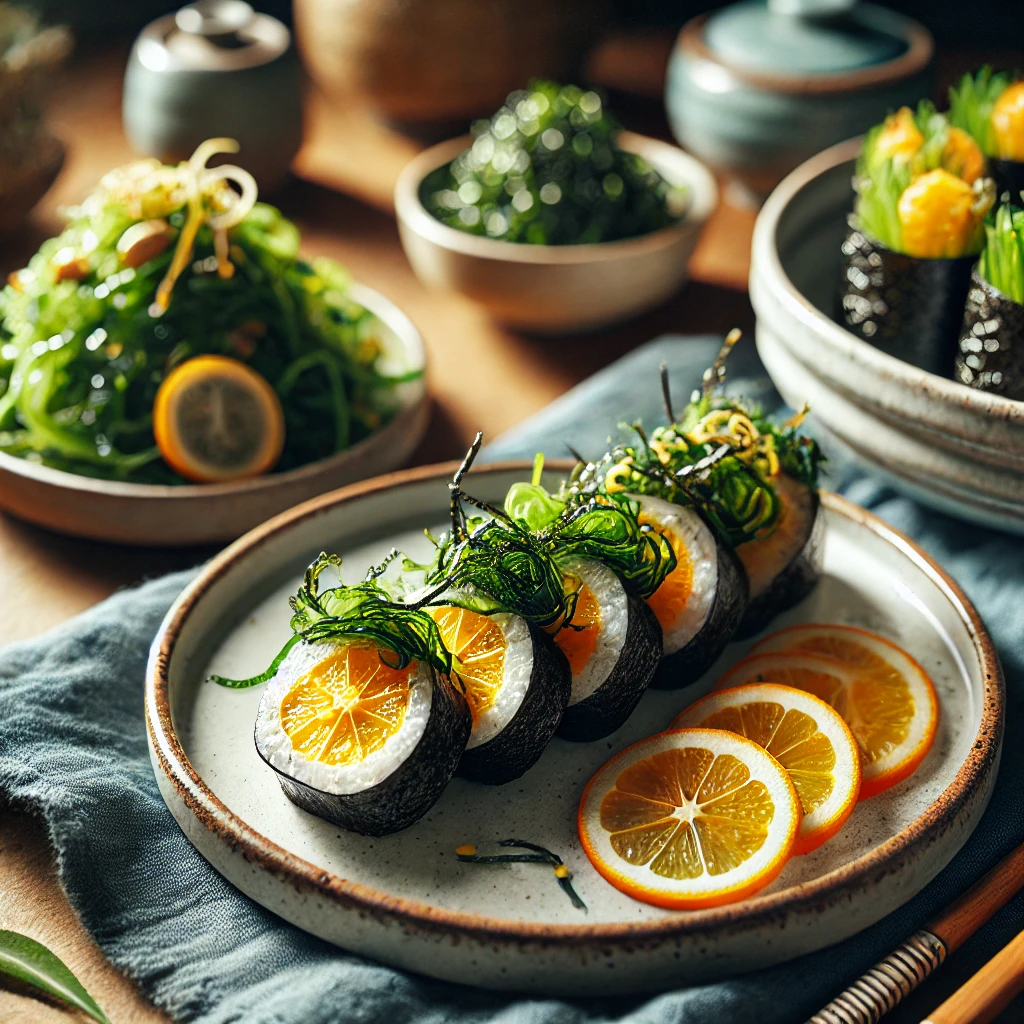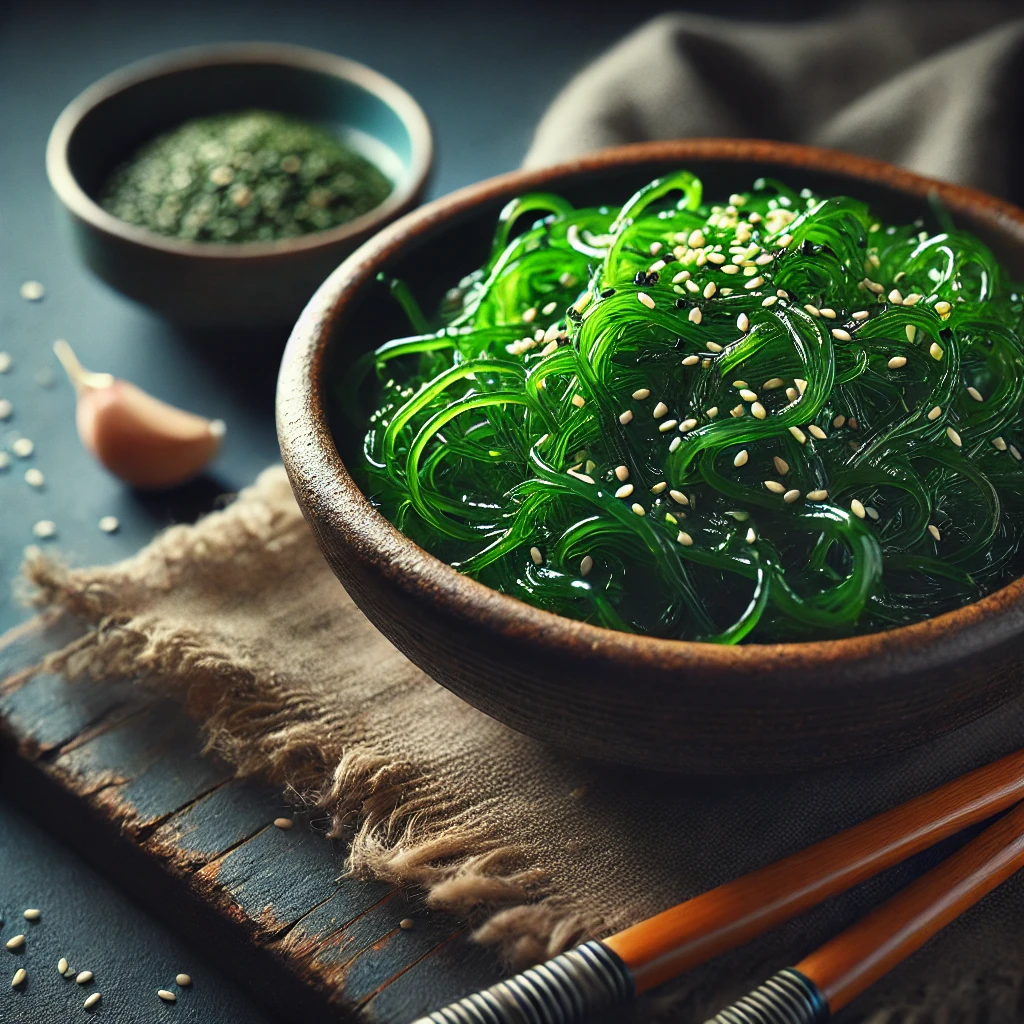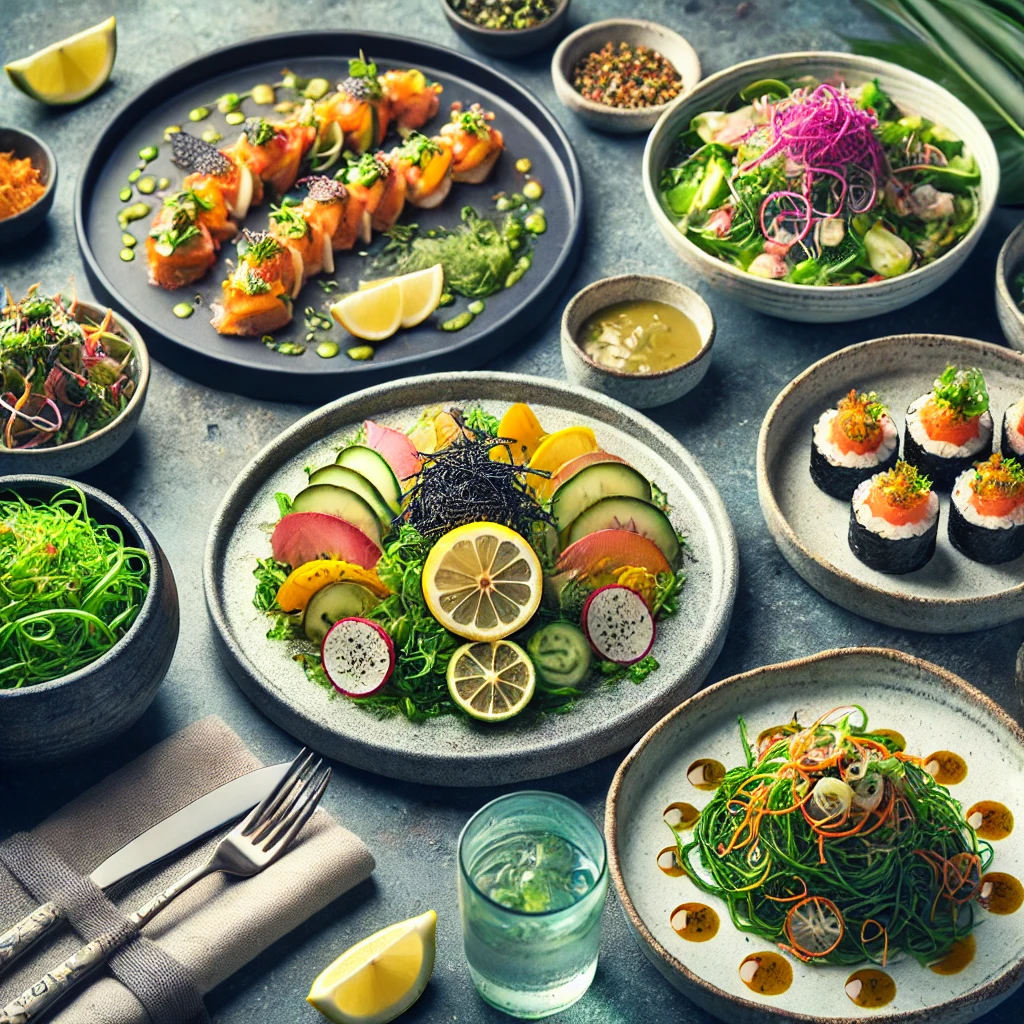
In the world of modern cuisine, superfoods have gained significant attention for their health benefits and versatile uses. Among the most prominent in Japanese and Korean cuisines are yuzu and seaweed. These ingredients, rooted deeply in the traditions of their respective cultures, are now making waves globally as health-conscious eaters and culinary enthusiasts explore their unique flavors and nutritional profiles. This blog post will delve into how yuzu and seaweed are shaping these Asian cuisines, their health benefits, and how you can incorporate them into your diet. We’ll also introduce you to our free guide, “The Global Healthy Eating Guide: Flexitarian Meals, Superfoods, and Fusion Recipes,” and recommend affiliate products to enhance your culinary experience.
The Rise of Superfoods in Modern Diets

What Are Superfoods?
Superfoods are nutrient-rich foods considered to be especially beneficial for health and well-being. They are packed with vitamins, minerals, antioxidants, and other essential nutrients that contribute to overall health. While the concept of superfoods is not new, their popularity has surged in recent years as more people seek out foods that offer more than just basic nutrition.
Yuzu and seaweed, staples in Japanese and Korean cuisines, are prime examples of superfoods that are gaining popularity worldwide. Their unique flavors, combined with their impressive health benefits, make them ideal for those looking to enhance their diets with more nutritious and flavorful ingredients.
Affiliate Product: Superfood Essentials
Before diving into the benefits and uses of yuzu and seaweed, consider stocking your kitchen with these essential tools:
- Zyliss Citrus Zester: Perfect for zesting yuzu and other citrus fruits, ensuring you get the most flavor out of your ingredients.
- GimMe Organic Seaweed Snacks: A healthy, convenient way to enjoy the benefits of seaweed in your daily diet.
Yuzu: The Citrus Superfood of Japan

What Is Yuzu?
Yuzu is a citrus fruit that originates from East Asia, primarily grown in Japan, Korea, and China. Resembling a small, rough-skinned lemon, yuzu is prized for its intensely fragrant aroma and its tart, tangy flavor, which is more complex than that of a typical lemon or lime. Unlike other citrus fruits, yuzu is rarely eaten on its own due to its sourness; instead, it is used as a flavoring agent in a variety of dishes and condiments.
Health Benefits of Yuzu
Yuzu is packed with vitamins and antioxidants, making it a powerful addition to your diet. Here are some of the key health benefits:
- Rich in Vitamin C: Yuzu contains three times more vitamin C than lemons, helping to boost the immune system, improve skin health, and protect against oxidative stress.
- Anti-inflammatory Properties: The antioxidants in yuzu help reduce inflammation, which can lower the risk of chronic diseases such as heart disease and arthritis.
- Improved Blood Circulation: Yuzu has been shown to promote better blood circulation, which is essential for cardiovascular health.
Culinary Uses of Yuzu in Japanese Cuisine
In Japan, yuzu is used in a variety of culinary applications, from sauces and marinades to desserts and beverages. Some popular uses include:
- Yuzu Kosho: A spicy, salty condiment made from yuzu zest, chili peppers, and salt, often used to flavor grilled meats and fish.
- Ponzu Sauce: A tangy sauce made from yuzu juice, soy sauce, mirin, and dashi, commonly used as a dipping sauce for sashimi and as a dressing for salads.
- Yuzu Tea: A traditional Korean and Japanese drink made by mixing yuzu marmalade with hot water, known for its soothing properties, especially during cold weather.
Affiliate Product:
- Yuzu Juice: Enjoy the authentic taste of yuzu with this high-quality yuzu juice, perfect for adding a citrusy kick to your dishes and beverages.

Recipe: Yuzu Miso Glazed Salmon
Ingredients:
- 4 salmon fillets
- 2 tablespoons yuzu juice
- 2 tablespoons white miso paste
- 1 tablespoon honey
- 1 tablespoon soy sauce
- 1 teaspoon grated ginger
Instructions:
- Preheat the oven to 400°F (200°C).
- In a small bowl, mix the yuzu juice, miso paste, honey, soy sauce, and ginger until smooth.
- Place the salmon fillets on a baking sheet lined with parchment paper.
- Brush the yuzu-miso mixture over the salmon fillets.
- Bake for 12-15 minutes, or until the salmon is cooked through and the glaze is caramelized.
- Serve with steamed rice and vegetables for a delicious, healthy meal.
Seaweed: The Ocean’s Superfood from Korea

What Is Seaweed?
Seaweed refers to various types of marine algae that are edible and commonly used in Asian cuisines. In Korea, seaweed is an essential ingredient in many traditional dishes, including soups, salads, and snacks. There are several varieties of seaweed, each with its unique flavor and texture, including nori (used in sushi), kelp, and wakame.
Health Benefits of Seaweed
Seaweed is one of the most nutrient-dense foods on the planet. Here are some of the key health benefits:
- High in Iodine: Seaweed is an excellent source of iodine, a mineral that is crucial for thyroid function and hormone production.
- Rich in Antioxidants: Seaweed contains various antioxidants, including vitamins A, C, and E, which help protect the body from oxidative stress.
- Supports Gut Health: Seaweed is high in fiber, which aids digestion and promotes a healthy gut microbiome.
Culinary Uses of Seaweed in Korean Cuisine
Seaweed is a versatile ingredient in Korean cooking, used in both traditional and modern dishes. Some popular uses include:
- Gim (Nori) Rolls: Gim is often used to wrap rice and other ingredients to make gimbap, the Korean version of sushi rolls.
- Miyeok-guk (Seaweed Soup): A traditional Korean soup made with miyeok (wakame seaweed), often eaten by new mothers to promote recovery and boost milk production.
- Seaweed Snacks: Crispy, roasted seaweed sheets seasoned with salt and sesame oil, commonly enjoyed as a healthy snack.
Affiliate Product:
- GimMe Organic Seaweed Snacks: A convenient and delicious way to enjoy the benefits of seaweed. Perfect as a snack or as an addition to your meals.

Recipe: Seaweed and Tofu Salad
Ingredients:
- 1 pack of tofu, cubed
- 1 cup dried wakame seaweed, rehydrated
- 1 cucumber, sliced
- 2 tablespoons soy sauce
- 1 tablespoon rice vinegar
- 1 teaspoon sesame oil
- 1 teaspoon sesame seeds
Instructions:
- Rehydrate the wakame seaweed by soaking it in warm water for 10 minutes, then drain and set aside.
- In a bowl, whisk together the soy sauce, rice vinegar, and sesame oil.
- In a large salad bowl, combine the tofu, wakame, and cucumber.
- Pour the dressing over the salad and toss to combine.
- Sprinkle with sesame seeds before serving.
Incorporating Yuzu and Seaweed into Your Diet

How to Start Using Yuzu and Seaweed at Home
Incorporating superfoods like yuzu and seaweed into your diet can be simple and rewarding. Here are some tips to get started:
- Experiment with Traditional Recipes: Start by trying out traditional Japanese and Korean recipes that use yuzu and seaweed. This will give you a good sense of how these ingredients are typically used and how they can enhance the flavor of your meals.
- Use as a Flavor Enhancer: Yuzu and seaweed are both excellent for adding flavor to a wide variety of dishes. Use yuzu juice or zest in salad dressings, marinades, and desserts. Add seaweed to soups, salads, and rice dishes for an umami boost.
- Incorporate into Your Daily Routine: Try incorporating these superfoods into your daily meals. For example, start your day with yuzu tea, enjoy a seaweed snack in the afternoon, and add a dash of yuzu juice to your dinner.
Free Guide:
To explore more ways to incorporate yuzu, seaweed, and other superfoods into your diet, download our free guide, “The Global Healthy Eating Guide: Flexitarian Meals, Superfoods, and Fusion Recipes.” This comprehensive guide offers delicious recipes, tips for a healthier lifestyle, and a 7-day meal plan designed to help you make the most of these powerful ingredients. Download your free guide today!
The Future of Yuzu and Seaweed in Global Cuisines

As global interest in superfoods continues to rise, yuzu and seaweed are becoming key players in the culinary world beyond Japan and Korea. These ingredients offer unique flavors and impressive health benefits, making them increasingly popular among chefs and home cooks alike. As a result, they are being incorporated into a wide variety of dishes, from gourmet restaurant creations to everyday meals.
Global Adoption of Yuzu and Seaweed
Yuzu and seaweed are not just confined to traditional Japanese and Korean dishes. They are being embraced by chefs around the world who are incorporating these superfoods into fusion cuisine, desserts, cocktails, and even wellness products.
- Yuzu in Western Cuisine: In the West, yuzu has found its way into everything from salad dressings and marinades to cocktails and desserts. The citrusy flavor of yuzu adds a refreshing twist to dishes, and its aromatic zest is being used to enhance the flavor of both sweet and savory recipes.
- Seaweed’s Expanding Role: Seaweed, long a staple in Asian diets, is now being recognized for its nutritional benefits in the West as well. It’s increasingly used as a healthful ingredient in soups, salads, snacks, and even in innovative products like seaweed chips and seaweed-infused beverages.
Emerging Culinary Trends
As the culinary world continues to evolve, we can expect to see even more creative uses of yuzu and seaweed:
- Fusion Dishes: As fusion cuisine grows in popularity, yuzu and seaweed will likely be used to create unique dishes that blend the flavors of different cultures. Imagine a yuzu-infused vinaigrette drizzled over a Mediterranean salad or seaweed used to add umami to a classic French soup.
- Plant-Based and Vegan Recipes: With the rise of plant-based and vegan diets, seaweed and yuzu offer flavorful, nutrient-rich options for enhancing plant-based dishes. Yuzu’s tangy flavor can brighten up vegetable-based meals, while seaweed can provide the umami taste often missing in vegetarian and vegan dishes.
Free Guide (Final Call to Action):
Ready to incorporate more yuzu and seaweed into your diet? Download “The Global Healthy Eating Guide: Flexitarian Meals, Superfoods, and Fusion Recipes” to discover delicious recipes, tips for using superfoods, and a 7-day meal plan that will help you make the most of these incredible ingredients. Download your free guide today and start your journey towards healthier, more flavorful meals!
Embracing Yuzu and Seaweed in Your Diet

Incorporating superfoods like yuzu and seaweed into your diet is a simple yet effective way to boost your health while enjoying delicious, flavorful meals. Whether you’re inspired by traditional Japanese and Korean dishes or looking to experiment with new fusion recipes, these ingredients offer endless possibilities.
With their rich nutritional profiles and versatility in the kitchen, yuzu and seaweed are set to become staples in kitchens around the world. So why not start exploring these superfoods today? Whether you’re adding a dash of yuzu juice to your favorite dish or enjoying a seaweed snack on the go, you’re sure to discover new and exciting flavors that will enhance your culinary experience.
Affiliate Product Summary:
- Zyliss Citrus Zester: Perfect for extracting the vibrant zest of yuzu and other citrus fruits, essential for adding a burst of flavor to your dishes.
- Yuzu Juice: A high-quality yuzu juice that’s ideal for enhancing your recipes with the unique citrus flavor of yuzu.
- GimMe Organic Seaweed Snacks: Convenient, delicious, and healthy seaweed snacks that are perfect for enjoying the benefits of seaweed wherever you are.
Embrace the superfoods revolution today and explore the vibrant flavors of yuzu and seaweed. With our free guide and the right tools, you’ll be well on your way to creating delicious, healthy meals that reflect the best of Japanese and Korean cuisines. Happy cooking!



Leave a Reply